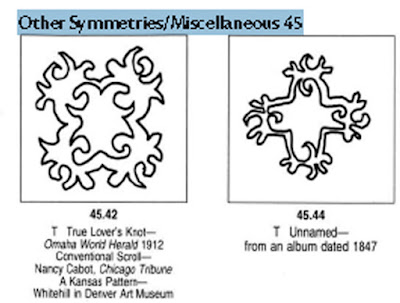An odd pattern, odd in that it is not symmetrical in four-way mirror image repeat
like many of its relations.
Not so odd in that it is unique or even unusual.
Odd as it is, it was a relatively popular applique after 1845 or so.
Used in repeat block albums like this one dated 1844 - 1847
made for Matilda Jones Swope of Liberty, Frederick County, Maryland.
Collection of the DAR Museum
Also seen as a single block in a sampler, this one about the
same time, pictured in William Dunton's book on his Maryland research.
Baltimore album from the collection of the Maryland Historical Society.
From a quilt in the collection of Mary Robare, the
authority on the pattern.
Mary's musings on cutting a pattern:
It is a variation of a more symmetrical design, a fleur-de-lis.
This mid-19th-century version of the standard design looks to be cut from one piece
of fabric like a paper snowflake, folded, snipped
and opened up to reveal the design.
And who has not snipped in the wrong place and opened
up their snowflake to reveal a novel design---not quite the
intention?
Baltimore Album quilt, collection of the Baltimore Museum of Art.
Some stitchers were very adept at cutting snow-flake style
fleur-de-lis. The variety is impressive.
Quilt dated 1844 for William and Gorgianna Burris Pindle.
From the book A Maryland Album
It looks like a mistake to me, but this pattern was handed around in some form,
not just one woman's error.
Collection of Debby Cooney
Quilters also added more motifs in the block corners.
Mid-20th century four-block from dealer Mark French's inventory
Quilt attributed to Julia Waldsmith Roseberry, (1819-1892) Ohio
Estimated date 1870-1900
These experiments in cutting with two-way mirror image
symmetry became a standard into the end of the century.
In Virginia they call it the Apple Pie Ridge Star block
after a neighborhood where it was popular.
Mary Robare's summary:
Karen Alexander also did a post about the pattern, showing
this block with the name in the center
"TRUE LOVER'S KNOT"
a name published in the Omaha World Herald in 1912.
In 1934 the Nancy Cabot quilt column in the Chicago Tribune
published a reader's design for Conventional Scroll.
Encyclopedia of Applique
Charlotte Jane Whitehill of Emporia, Kansas made a 20th-century version
and called hers "A Kansas Pattern".
See Karen's post on the pattern:
Some late 19th/early 20th century examples, free-hand cut (?) with a variety of results.
Print this out on an 8-1/2" x 11" sheet and you'll
have a pattern for a 12" block, but be careful
in doing the snowflake folding and cutting. You could wind up with a new pattern.
I tried it on a 12" square of newspaper.
Michelle has a Pinterest page
























dd
ReplyDelete